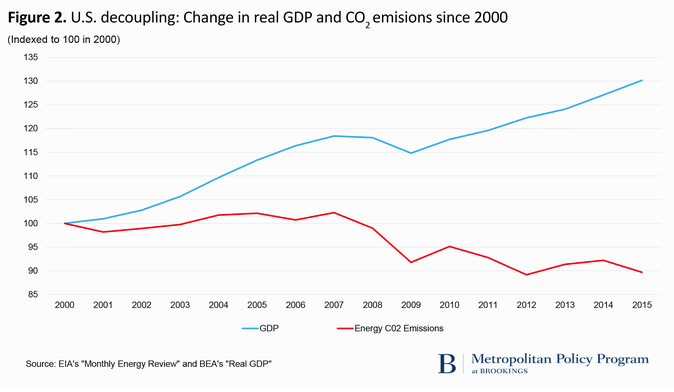A new Brookings Institute report discusses the “decoupling” of state economic growth with carbon dioxide emissions. The authors put it in context of President-elect Donald Trump’s possible energy policies. I see stand-alone lessons.
For example, take a look at this chart from the report. You will notice that U.S. emissions began a noticeable decline around 2007, after hydraulic fracturing (“fracking”) was successfully combined with horizontal drilling to unlock incalculable U.S. reserves of oil and natural gas hitherto trapped in shale. It was one of the greatest technological innovations in recent memory, leading to a remarkable revolution in energy.
I have discussed this here frequently — most recently under the heading “Led by natural gas, CO2 emissions have been falling as media, leftists make it sound as if we’re on the brink of disaster.”
To me, this represents a remarkable and prototypically American feat: risk-taking entrepreneurs somehow finding a way that solves not just one, but it turns out three problems at once:
- How do I make money and sustain my family and my business?
- How can the United States get free of dependence upon oil-rich tyrannies and kleptocracies?
- How can we reduce emissions without compromising individual freedom and visiting great economic harm on people, especially the poor, by imposing ill-researched, top-down government diktats fraught with cronyism and unforeseen negative consequences?
I explored it further in my Spotlight on “Natural Gas: Low-Cost Energy Source that Curbs Emissions and Land Impacts.”
In that report I highlight, among other things, how the shift to natural gas in electricity generation over the last decade has produced actual reductions in emissions. Researchers at the National Oceanic and Atmospheric Administration (NOAA) found that the increased use of natural gas for electricity generation was responsible for the following reductions per unit of power produced from 1997 to 2012:
- 23% lower CO2 emissions
- 40% lower SO2 emissions
- 44% lower NOx emissions
The U.S. Energy Information Agency has shown that actual, falling carbon dioxide emissions over the last decade are mostly because of the change to natural gas in electricity generation.
Emissions reductions in North Carolina
Back to the Brookings report, I saw this finding for North Carolina (see Figure 3):
- 26.3% growth in GDP, 2000–14
- 14.6% reduction in CO2 emissions, 2000–14
Now in explaining this change, this “decoupling” of emissions from economic growth, the authors mention the changes in the states’ economies (e.g., moving more into service industries and away from manufacturing). Primarily, however,
Determining even more of the varied state-by-state decoupling stories are significant differences in energy sourcing across regions, these often also driven by market-ordained price changes, such as the decline of natural gas prices made possible by the “fracking” revolution.
Northeastern and many Southern states, for example, have achieved some of the most impressive feats of decoupling, and their achievement owes to mostly favorable changes in the states’ fuel mixes, such as through the substitution of natural gas for coal in power plants.
Specifically,
In short, the combination of nuclear plants and coal’s replacement by natural gas has enabled many Southern states to pull off some of the most dramatic decouplings in the country. Like Georgia, North Carolina has supported its double-digit growth and emissions reductions in large part by sourcing nearly 32 percent of its electricity from nuclear and 22 percent from natural gas. Coal-based generation has fallen to just 38 percent.
And if you’d like to make that reach for renewables, they barely register:
A note about renewables is in order, meanwhile: wind and solar generation have yet to register as broad an impact on decoupling as might be expected—even in the green West. In this regard, while solar and wind’s share of electricity generation has been on the rise, its large-scale growth in some states dates only to the last decade, and so this analysis does not find a strong statistical relationship between states’ emissions reductions and solar and wind’s share of power generation.
Again: natural gas and nuclear are practical low-emission energy sources that are also the least costly.


